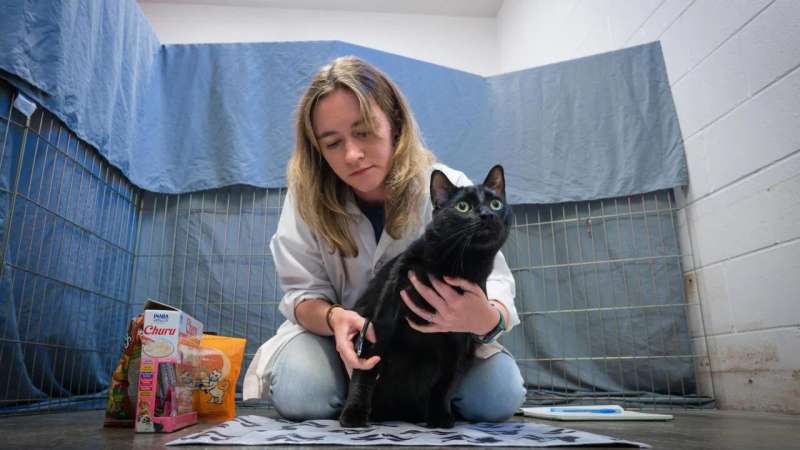
Animal Science Ph.D. student Jen Link works with a cat at the Sacramento SPCA on the best way to create a stress-free nail trimming experience for the animal and humans. Credit: Jael Mackendorf /UC Davis
University of California, Davis, researchers are working with the Sacramento SPCA to alleviate a near-universal source of stress for cats and those who care for them: nail trimming.
Clipping a cat or kitten’s nails should be a routine practice, not only for the health of the cat and humans, but also to protect curtains, couches and other housewares.
But it can be a nerve-wracking task for all involved, and the noise and discomfort of a shelter can increase anxiety.
Ph.D. student Jennifer Link, who is in the UC Davis Animal Welfare Epi Lab, is working to lessen the trauma through a multistep protocol intended to desensitize the felines to handling and then nail clipping.
In mid-July, Link began visiting the Sacramento shelter each weekday in two-hour shifts to work on socializing rescued and surrendered cats to help ease their reactivity to new people, actions and environments. By the end of September, she had seen more than 70 cats.
“When people hear that I study cats, many ask if I can help them with nail trims,” Link said. “We know that socialization matters throughout life.”
Dan Marple, the animal welfare manager at the Sacramento Society for the Prevention of Cruelty to Animals, said the research is of paramount interest to staff, volunteers and donors because it can reduce the stress of this necessary grooming need.
“Any new protocols that increase the comfort and safe handling of the cats in our care will also improve their overall well-being and adoptability,” he said.
The cats decide
Link’s research incorporates cooperative care, which lets the animals decide their level of interaction during the training process. The cats go through one of three scenarios with Link: a handling and nail trim training protocol, a handling-only training protocol, or a control with no training and only a nail trim. Each interaction is recorded for later analysis.
Credit: UC Davis
The protocol groups involve habituation to get the cats comfortable. On those days, they are removed from their cages and placed in a quiet shelter room where Link is sitting, with a mat laid out before her. If a cat puts their front two paws on the mat, they are given pets and a treat. The cat is meant to learn that Link interacts with them only when they place their paws on the mat. Once this is learned, Link moves forward with the training protocols.
In steps, Link touches the cat’s legs, then the paws and then those paws get a gentle squeeze. If they don’t resist, one nail is trimmed.
The procedure builds on past steps and works up. Once the cat has gone through all the steps, they get a nail trim. If a cat doesn’t interact or rejects any step, Link stops the handling. “I think with the cooperative care, it does seem to almost improve their trust in me,” Link said. “They are more comfortable if we let them decide.”
Improving life in the shelter
The work is funded as part of an American Society for the Prevention of Cruelty to Animals applied behavior grant awarded to Carly Moody, an assistant professor who runs the Animal Welfare Epi Lab. The goal is to improve the welfare of cats during the routine procedure of handling and nail trims.
Moody said the protocol could be taught to volunteers, in order to change an often-stressful experience into a more positive experience for both the handler and the cat.
“A lot of cats in the shelter want affection,” Moody said. “Hopefully in the future something like this could be incorporated into shelter cat enrichment and management programs.”
It could also help owners at home and decrease the number of visits to clinics and veterinary hospitals, where people often seek help with nail clipping, Marple said.
“A lot of owners don’t have the tools to make nail trimming more positive,” Moody said.
Next, researchers will analyze the video sessions and finalize the protocol. If the protocol is found to be helpful, they may share it with cat managers at other shelters for additional data and input.
Citation:
Can science find a better way to trim a cat’s nails? (2023, December 1)
retrieved 1 December 2023
from https://phys.org/news/2023-12-science-trim-cat.html
This document is subject to copyright. Apart from any fair dealing for the purpose of private study or research, no
part may be reproduced without the written permission. The content is provided for information purposes only.
>>> Read full article>>>
Copyright for syndicated content belongs to the linked Source : Phys.org – https://phys.org/news/2023-12-science-trim-cat.html






























